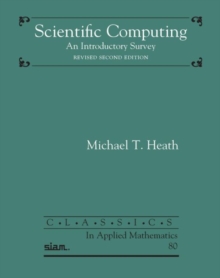
Mathematical Models and Their Analysis Paperback / softback
by Frederic Y.M. Wan
Part of the Classics in Applied Mathematics series
Paperback / softback
Description
A great deal can be learned through modeling and mathematical analysis about real-life phenomena, even before numerical simulations are used to accurately portray the specific configuration of a situation.
Scientific computing also becomes more effective and efficient if it is preceded by some preliminary analysis.
These important advantages of mathematical modeling are demonstrated by models of historical importance in an easily understandable way. The organization of Mathematical Models and Their Analysis groups models by the issues that need to be addressed about the phenomena.
The new approach shows how mathematics effective for one modeled phenomenon can be used to analyze another unrelated problem.
For instance, the mathematics of differential equations useful in understanding the classical physics of planetary models, fluid motion, and heat conduction is also applicable to the seemingly unrelated phenomena of traffic flow and congestion, offshore sovereignty, and regulation of overfishing and deforestation.
The formulation and in-depth analysis of these and other models on modern social issues, such as the management of exhaustible and renewable resources in response to consumption demands and economic growth, are of increasing concern to students and researchers of our time. The modeling of current social issues typically starts with a simple but meaningful model that may not capture all the important elements of the phenomenon.
Predictions extracted from such a model may be informative but not compatible with all known observations; so the model may require improvements.
The cycle of model formulation, analysis, interpretation, and assessment is made explicit for the modeler to repeat until a model is validated by consistency with all known facts.
Information
-
Available to Order - This title is available to order, with delivery expected within 2 weeks
- Format:Paperback / softback
- Pages:402 pages
- Publisher:Society for Industrial & Applied Mathematics,U.S.
- Publication Date:30/05/2018
- Category:
- ISBN:9781611975260
Information
-
Available to Order - This title is available to order, with delivery expected within 2 weeks
- Format:Paperback / softback
- Pages:402 pages
- Publisher:Society for Industrial & Applied Mathematics,U.S.
- Publication Date:30/05/2018
- Category:
- ISBN:9781611975260









